Results 1 to 2 of 2
Thread Information
Users Browsing this Thread
There are currently 1 users browsing this thread. (0 members and 1 guests)
-
09-11-2013, 10:43 PM #1
Congress' border efforts are bunk, say border sheriffs
Alan Gomez, USA TODAY 9:32 p.m. EDT September 11, 2013
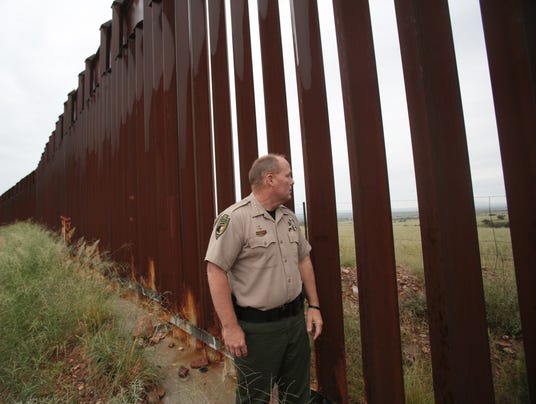
(Photo: David M. Sanders for USA TODAY)
The bill passed by the Senate in July attempts to solve the problem of illegal immigration with a $46 billion "border surge," adding 20,000 new Border Patrol agents, and $3 billion in new monitoring technology. But sheriffs policing the border say that misses the mark.
SIERRA VISTA, Ariz. — It's monsoon season in southern Arizona, so Cochise County Sheriff Mark Dannels has to drive slowly along the hilly, rocky, muddy terrain that covers the 83-mile border his county shares with Mexico.
He scans the horizon to see whether any immigrants or drug smugglers are approaching the 4-foot-high border fence. Glancing at the lights of a city in Mexico, he turns and says, "Seen any Border Patrol agents?"
Dannels' complaints about the lack of Border Patrol agents along the border suggests he supports a Senate plan to flood the Southwest border with 20,000 new agents. But he doesn't. He doesn't think border security proposals in the House will do much, either.
"The people in my county are very frustrated," Dannels says, looking at the lush green of a valley that will soon shrivel to brown in the desert sun. "They feel border security hasn't been taken seriously."
Congress returned from recess this week facing a busy schedule, featuring debates over Syria, health care and the debt limit.
But Rep. Bob Goodlatte, R-Va., chairman of the House Judiciary Committee, said they also will find time to dive into immigration.
The Senate and House have spent months crafting their own versions of overhauls to the nation's immigration laws. Yet Dannels is among more than a dozen sheriffs interviewed by USA TODAY who police the border from California to Texas and say the plans from Washington will do little to secure the border.
They say they have proposals that will work — more prosecutions of border crossers, closer screening of people going through border crossings, putting pressure on Mexico to do its part. But they feel they've been shoved aside by a Congress more interested in cutting a deal than finding solutions.
"They've had every organization up there except law enforcement. I just don't understand that," said Doña Ana County, N.M., Sheriff Todd Garrison. "If we just had a seat at the table and could express our concerns, it would at least shed some light on these issues."
BORDER AGENTS VS. BORDER STRATEGY
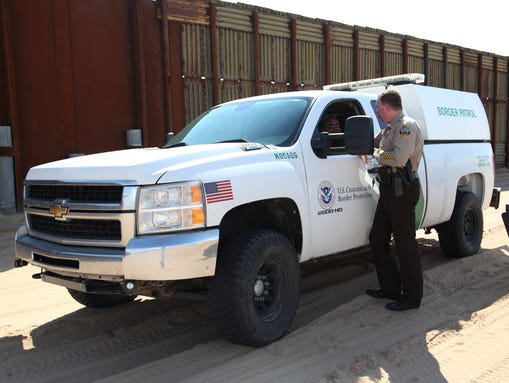
Yuma County Sheriff Leon Wilmot talks to a U.S. Customs and Border Protection agent, who is patrolling the area along San Luis, Ariz., and the Mexican border.(Photo: Crystal Ochoa for USA TODAY)
The border with Mexico is a nearly 2,000-mile range of starkly differing terrain where the problems of how to stop illegal immigration depend on where you are — the beaches of San Diego, the mountains of Arizona, the wide-open deserts of New Mexico or the swift rivers in Texas.
The sweeping immigration bill passed by the Senate in July attempts to solve the problem with a $46 billion "border surge" that is mostly spent on adding 20,000 new Border Patrol agents, and $3 billion in new monitoring technology, including sensors, radars, drones and helicopters.
That surge won over Senate Republicans who pushed for a secure border before they could agree to grant a pathway to citizenship for the nation's undocumented immigrants, a provision that Democrats have insisted on.
But of the 17 sheriffs interviewed by USA TODAY, whose jurisdictions cover most of the U.S.-Mexico border, only one said they felt all those new agents were needed. The rest said they feel Border Patrol simply needs a new strategy and new technology.
"They're tripping over themselves now," Hudspeth County, Texas, Sheriff Arvin West said of the current 18,500 Border Patrol agents working the Southwest border.
The problem, West says, is that Border Patrol agents are no longer on the border, but working many miles inland. West has spent 30 years in the western Texas county where most of the border fence consists of posts strung with a few strands of barbed wire. It's dangerous work to patrol the wild, rugged terrain in the middle of the night.
He, like all other sheriffs interviewed, respect the Border Patrol agents who risk their lives to keep the border safe and secure.
"But put them on the damned border," he said. "In some places here, they are 60, 70 miles away. It's going to take some (courage) to go down there. When you first get down there ... you're going to (tick) the drug dealers off. But once they understand that you held the line, they're going to look for weaker spots further down the line."
From his years of experience, Sheriff Clint McDonald in Terrell County, Texas, knows that there are 38 points in his county where people from Mexico can cross the Rio Grande. Yet Border Patrol does not go there.
"I guess I'm stupid, but I would think if you put people at those 38 crossings, people wouldn't come across," he said.
But in many areas along the border, federal Border Patrol agents spend most of their time patrolling roads and highways farther inland. Typically, drivers on Interstate 8 in California, I-19 in Arizona and I-10 in Texas see Border Patrol at highway checkpoints where agents wave most cars through, but stop suspicious-looking vehicles for additional screening.
"Why can we drive 10 miles on the border and see three Border Patrol agents, but drive 3 miles north to our checkpoint and you have 30 (Border Patrol) vehicles parked there?" asked Sheriff Dannels in Cochise County. "That makes no sense."
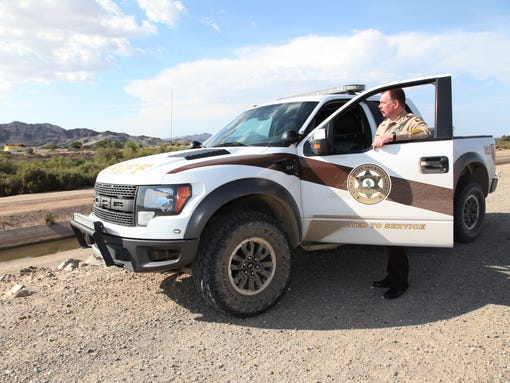
Yuma County, Ariz., Sheriff Leon Wilmot has 84 deputies to help him patrol 5,519 square miles of the county and 95 miles along the Mexican border, in conjunction with agents with U.S. Customs and Border Protection.(Photo: Crystal Ochoa for USA TODAY)
Customs and Border Protection spokesman Michael Friel said the highway checkpoints are part of a "layered" approach to the border where agents catch "consolidated smuggling loads" on their way north.
"Checkpoints deny major routes of egress from the borders to smugglers intent on delivering people, drugs and other contraband to the interior of the United States and allow the Border Patrol to establish an important second layer of defense," Friel said.
Border sheriffs say they feel the Senate's focus on more agents also ignores the benefits of technology and intelligence, which would greatly expand capture and detection capabilities without adding thousands of more pairs of eyes and trucks on the border.
In Kinney County, Texas, Border Patrol agents rely on local deputies to help spot border crossers because the locals have high-powered, night-vision telescopes mounted on their trucks.
"They got Vietnam-era scopes," said Kinney County Sheriff Leland Burgess. "So we go to the river every night. We help them catch a lot of traffic, whether it be drugs or illegal aliens."
Sheriffs also say they feel that agents can do more investigative work to be more effective.
In Cochise County, Sheriff Dannels has assigned two deputies to spend a portion of each day with ranchers and then share whatever they learn with Border Patrol. San Diego County Sheriff Gore uses the same concept on a much larger scale.
His "Border Suppression Team" works with Border Patrol, local police agencies, state troopers and other federal law enforcement agencies like the Drug Enforcement Agency to gather intelligence and take down smuggling activities entering the county.
"Everybody focuses on a fence and, to me, that's just short-sighted," Gore said.
Members of the Gang of Eight senators that sponsored the bill said they never intended their border security approach to be the final solution. This was just their attempt to strike the right balance between "technology, manpower and consequences" for lawbreakers.
"We made a commitment to ensure that the border is secure, and deploying additional agents is a component of that commitment," said Sen. Jeff Flake, R-Ariz., a Gang of Eight member.
"To the extent its members need to do so, the House has a chance to improve upon the border security provisions."
PORTS, PROSECUTIONS, POLITICS
The border sheriffs say another failing of the "surge" approach shows that Washington doesn't fully understand how — or how often — people illegally cross the border.
"Are people coming across? Yes. They're coming right through the ports," said Santa Cruz County, Ariz., Sheriff Tony Estrada.
Sheriffs say they're seeing more people trying to cross using false documents. Cartels also monitor how federal officials operate at the border crossings, known as land ports of entry, and devise strategies to beat them. For example, they'll wait for a shift change, then rush multiple drug-filled cars across, knowing most will get past inspectors.
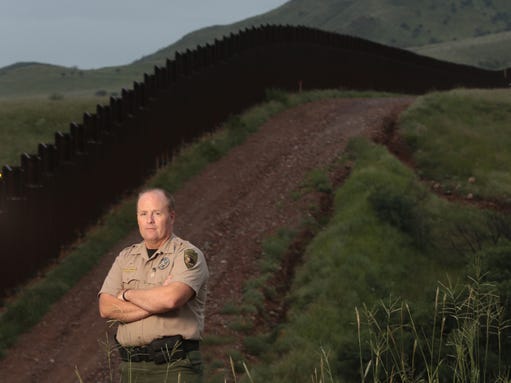
Cochise County, Ariz., Sheriff Mark Dannels, stands at the border fence near the Huachuca Mountains of southern Arizona.(Photo: David M. Sanders for USA TODAY)
Some sheriffs said a major investment in personnel specifically at border crossings also would cut into the money and guns that flow south, which are then used to help more smugglers make the trek north.
"I'm not saying we should become East Germany and make sure people can't leave the country," said Luna County, N.M., Sheriff Raymond Cobos. "But if they're leaving the country in cars, they should get inspected thoroughly with the same kind of technology as the people coming in."
The Senate bill at one point recognized the importance of shoring up the crossings when it designated 3,500 new officers to the ports of entry. But the bill was amended to emphasize adding 20,000 agents to patrol the regions between those ports.
Sheriffs also wonder why those in Washington have barely addressed what should be an overwhelming deterrent to illegal immigration: federal prosecutions.
Sheriff Leon Wilmot in Yuma County, Ariz., said the billions of dollars being proposed for border security would be better spent on the federal justice system to ensure that everybody who crosses the border illegally is prosecuted and swiftly deported.
Prosecutors are so short-handed that they refuse to take on many cases, Wilmot said.
He said prosecutors won't take drug cases when fewer than 1,500 pounds of marijuana are confiscated. They won't take a cocaine or methamphetamine case if there's less than a pound. And he said they won't take any cases when the drug runners are juveniles.
"Unless it's handed to them on a silver platter with a confession, they won't take it," Wilmot said.
The Senate bill does call for more funding for prosecutors, public defenders and court personnel, but only for one section of the border — the Tucson Sector of Arizona. Wilmot and others said every sector of the border needs the help.
"The prosecutions along the border are becoming a joke," McDonald said. "You see it time and time again on the news, that this person committed a crime and has been deported 15 times. Let them know that when you come across that border, you're going to get prosecuted."
The border sheriffs proposed another suggestion that has not been made part of the Washington approach: Mexico can do more.
The United States has given Mexico more than $1.6 billion since since 2008 to improve its justice system. Sheriff Omar Lucio in Cameron County, Texas, said the U.S. should dictate that large portions of that funding go to securing the border from the Mexico side.
"When you have a well-trained, well-staffed and well-disciplined law enforcement agency and you put them on their border, I guarantee you not only will you stop people from going from Mexico to the United States, but you'll put a big dent into the drug cartel business," he said.
THE FENCE
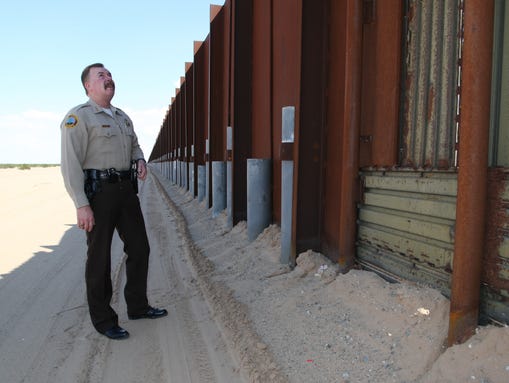
Yuma County Sheriff Leon Wilmot examines the border fence between San Luis, Ariz., and Mexico.(Photo: Crystal Ochoa for USA TODAY)
Then there is what many in the Republican Party have said is the obvious solution: a fence.
A group of border sheriffs recently traveled to Israel to see the security barrier there — a mostly chain-link fence and some concrete preventing Palestinians from entering Israel illegally. Israel credits the fence with a huge drop in terror attacks.
Some sheriffs who saw the barrier thought that the U.S. could use a similar structure, and a similar commitment to manning it, to seal the border to illegal immigration.
"Yes, if we want to," Sheriff McDonald said. But "I realized that our country does not have the political will to secure our border."
A border fence in Southern California similar to that used in Israel (razor wire, double and triple fences and cameras) is credited by the Department of Homeland Security as having brought down illegal crossings significantly. Twenty years ago, 530,000 arrests were made in San Diego; in FY 2012 there were fewer than 30,000.
But most sheriffs said a fence won't work in the often desolate portions of the border, where 651 miles of varying types of fence line about a third of the border. They said they don't think it's feasible in the USA because it would be expensive, entail unpopular land-takings and still need a lot of manpower to thwart attempts at passage.
"It didn't work in China. It didn't work in Germany," said Hidalgo County, Texas, Sheriff Lupe Treviño. "It's a senseless, stupid thing."
San Diego County Sheriff Bill Gore said the effectiveness of a fence depends on the geography.
Gore said it works in California because people would race from Tijuana to San Diego, a short sprint often done right across a highway.
"Here, it makes perfectly good sense," Gore said. "But in the middle of the desert, to me, it doesn't make a lot of sense."
HOUSE PROPOSALS
Not one sheriff backed a House proposal by Rep. Trey Gowdy, R-S.C., to give state and local governments the ability to pass immigration bills that mirror federal immigration laws and have their local officers enforce them.
"If I wanted to do that, I would've joined Border Patrol or (Immigration and Customs Enforcement)," said Presidio County, Texas, Sheriff Danny Dominguez.
The cost of arresting, incarcerating and prosecuting undocumented immigrants also worried the sheriffs. Sheriff Lucio of Cameron County said his 1,700-bed jail already at capacity.
"If the (federal government) builds a jail where I have 5,000 beds, then OK, I can help you," he said.
The one proposal coming out of Washington that garnered some praise from the border sheriffs was a House attempt to understand the state of the border.
A bill by Rep. Michael McCaul, R-Texas, who chairs the House Homeland Security Committee, requires DHS to spend six months measuring the state of border security, then develop a plan to secure it.
After two years, DHS would have to certify that it's monitoring 100% of the border, and after five years, it would have to certify that agents are stopping or turning back 90% of people trying to cross it. The proposal calls for much more technology on the border.
Webb County, Texas, Sheriff Martin Cuellar said McCaul "hit everything right on the nail."
"They're talking about cameras all over the area," Sheriff Lucio said. "(McCaul)'s got a good idea there."
But others wondered why it was necessary to spend even more time researching the state of the border.
"The federal government loves to do studies," said Imperial County, Calif., Sheriff Raymond Loera. "How many more studies do we need?"
And some questioned how the agency can realistically determine how many people crossed the border unnoticed.
Asked Sheriff Burgess: "How are you going to tell when you got 90%? Are you gonna set up on Interstate 10 with a clicker?"
http://www.usatoday.com/story/news/n...gress/2770807/Support our FIGHT AGAINST illegal immigration & Amnesty by joining our E-mail Alerts at https://eepurl.com/cktGTn
-
09-13-2013, 12:02 AM #2
Added to Homepage:
http://www.alipac.us/content.php?r=2...order-sheriffsSupport our FIGHT AGAINST illegal immigration & Amnesty by joining our E-mail Alerts at https://eepurl.com/cktGTn


 LinkBack URL
LinkBack URL About LinkBacks
About LinkBacks




 Reply With Quote
Reply With Quote


Predicted consequences of Biden’s planned invasion, comes to...
04-15-2024, 02:01 PM in General Discussion